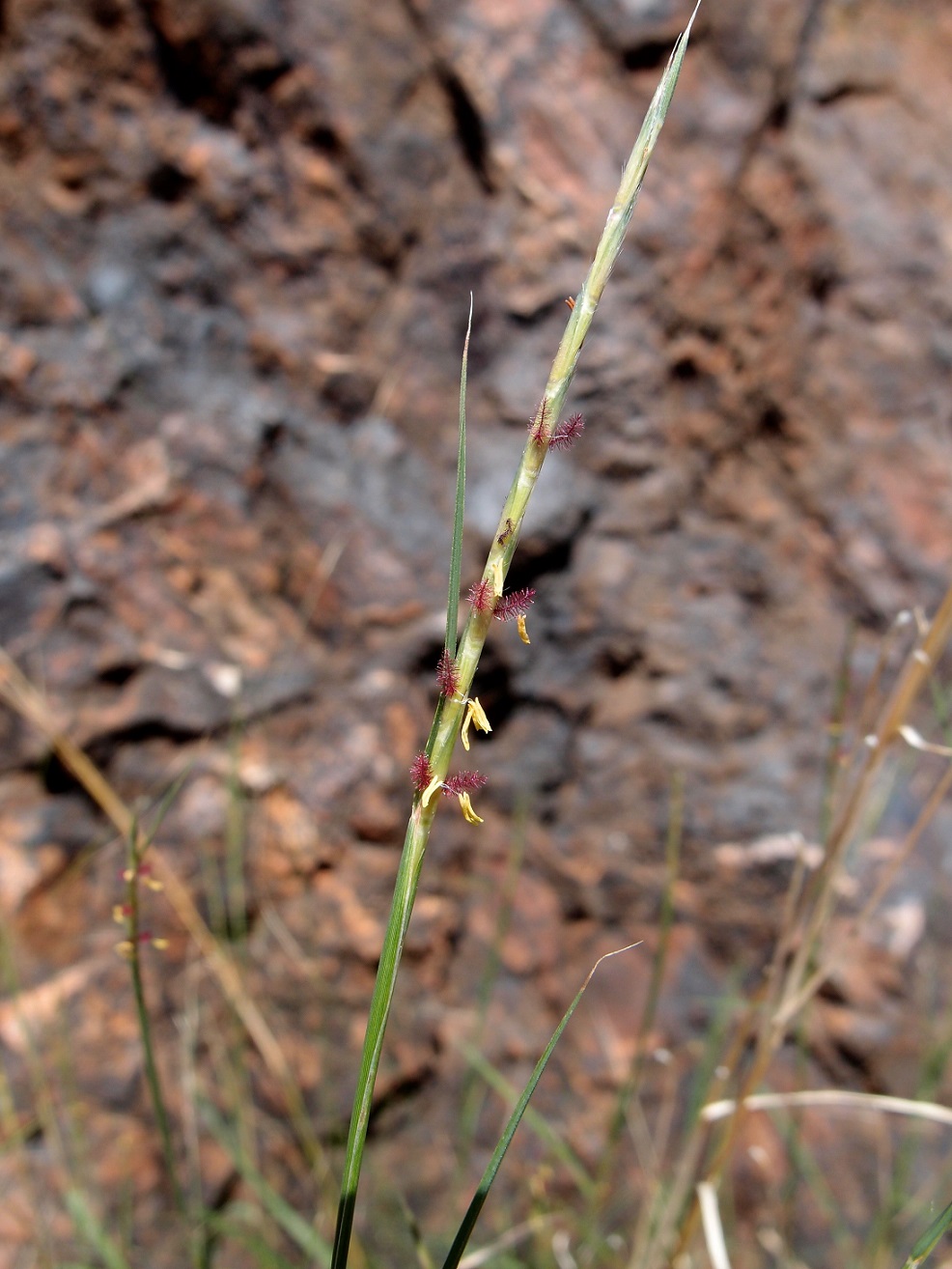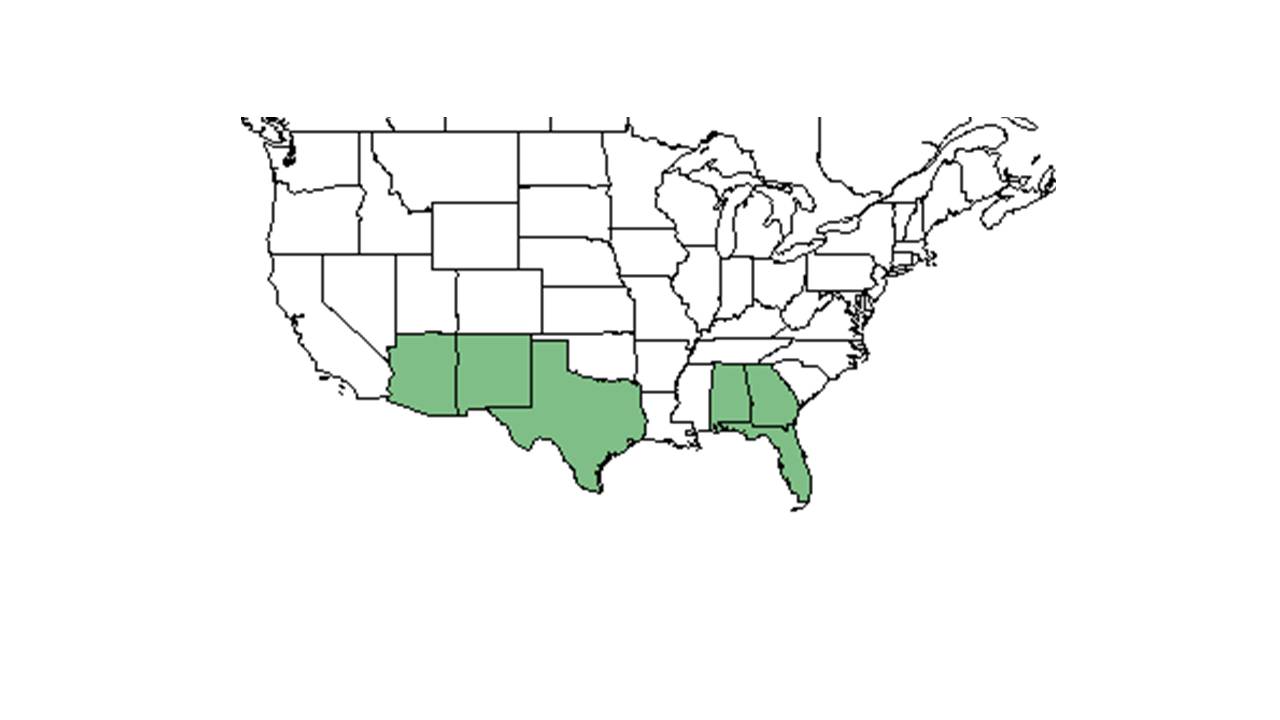Difference between revisions of "Schizachyrium sanguineum"
Krobertson (talk | contribs) |
|||
| Line 18: | Line 18: | ||
}} | }} | ||
| − | Common name: | + | Common name: Crimson bluestem |
==Taxonomic notes== | ==Taxonomic notes== | ||
Synonyms: ''Andropogon hirtiflorus'' (Nees) Kunth; ''Schizachyrium sanguineum'' var. ''brevipedicellatum'' (Beal) Hatch | Synonyms: ''Andropogon hirtiflorus'' (Nees) Kunth; ''Schizachyrium sanguineum'' var. ''brevipedicellatum'' (Beal) Hatch | ||
| Line 29: | Line 29: | ||
===Habitat=== <!--Natural communities, human disturbed habitats, topography, hydrology, soils, light, fire regime requirements for removal of competition, etc.--> | ===Habitat=== <!--Natural communities, human disturbed habitats, topography, hydrology, soils, light, fire regime requirements for removal of competition, etc.--> | ||
In the Coastal Plain in Florida, ''S. sanguineaum'' can be found in wet hammocks, pine flatwoods on limerocks, scrub oak barrens, sandy old fields, turkey oak sand ridges, longleaf pine-deciduous scrub oak forests, and pine-scrub oak sand ridges. <ref name="FSU Herbarium">Florida State University Robert K. Godfrey Herbarium database. URL: [http://herbarium.bio.fsu.edu http://herbarium.bio.fsu.edu]. Last accessed: July 2015. Collectors: R.K. Godfrey, Loran C. Anderson, John B. Nelson, Rhonda Riggins, Sidney McDaniel, R. Kral, D. B. Ward, J. Hunter, F. S. Ward, J. P. Gillespie. States and Counties: Florida: Calhoun, Dade, Escambia, Gilchrist, Lake, Leon, Liberty, Madison, Monroe, Okaloosa, Wakulla, Walton, Washington. Compiled by Tall Timbers Research Station and Land Conservancy.</ref> It can be found in reddish sandy soils. <ref name="FSU Herbarium"/> Associated species include ''Pityopsis adenolepis, Cladonia, Warea, Crotonopsis, Lechea, Paronychia, Pityopsis aspera, Eupatorium pinnatifidum, Gnaphalium obtusifolium, Diodia teres'', centipede grass and bahia grass. <ref name="FSU Herbarium"/> | In the Coastal Plain in Florida, ''S. sanguineaum'' can be found in wet hammocks, pine flatwoods on limerocks, scrub oak barrens, sandy old fields, turkey oak sand ridges, longleaf pine-deciduous scrub oak forests, and pine-scrub oak sand ridges. <ref name="FSU Herbarium">Florida State University Robert K. Godfrey Herbarium database. URL: [http://herbarium.bio.fsu.edu http://herbarium.bio.fsu.edu]. Last accessed: July 2015. Collectors: R.K. Godfrey, Loran C. Anderson, John B. Nelson, Rhonda Riggins, Sidney McDaniel, R. Kral, D. B. Ward, J. Hunter, F. S. Ward, J. P. Gillespie. States and Counties: Florida: Calhoun, Dade, Escambia, Gilchrist, Lake, Leon, Liberty, Madison, Monroe, Okaloosa, Wakulla, Walton, Washington. Compiled by Tall Timbers Research Station and Land Conservancy.</ref> It can be found in reddish sandy soils. <ref name="FSU Herbarium"/> Associated species include ''Pityopsis adenolepis, Cladonia, Warea, Crotonopsis, Lechea, Paronychia, Pityopsis aspera, Eupatorium pinnatifidum, Gnaphalium obtusifolium, Diodia teres'', centipede grass and bahia grass. <ref name="FSU Herbarium"/> | ||
| − | |||
===Phenology=== <!--Timing off flowering, fruiting, seed dispersal, and environmental triggers. Cite PanFlora website if appropriate: http://www.gilnelson.com/PanFlora/ --> | ===Phenology=== <!--Timing off flowering, fruiting, seed dispersal, and environmental triggers. Cite PanFlora website if appropriate: http://www.gilnelson.com/PanFlora/ --> | ||
It has been recorded to flower August through November. <ref name="FSU Herbarium"/> | It has been recorded to flower August through November. <ref name="FSU Herbarium"/> | ||
| Line 38: | Line 37: | ||
<!--===Use by animals===--> <!--Herbivory, granivory, insect hosting, etc.--> | <!--===Use by animals===--> <!--Herbivory, granivory, insect hosting, etc.--> | ||
<!--===Diseases and parasites===--> | <!--===Diseases and parasites===--> | ||
| − | |||
==Conservation and management== | ==Conservation and management== | ||
| − | |||
==Cultivation and restoration== | ==Cultivation and restoration== | ||
==Photo Gallery== | ==Photo Gallery== | ||
<gallery widths=180px> | <gallery widths=180px> | ||
</gallery> | </gallery> | ||
| − | |||
==References and notes== | ==References and notes== | ||
Revision as of 13:43, 15 September 2016
| Schizachyrium sanguineum | |
|---|---|

| |
| Photo and permission by Sue Carnahan SEINet Arizona – New Mexico Chapter | |
| Scientific classification | |
| Kingdom: | Plantae |
| Division: | Magnoliophyta – Flowering plants |
| Class: | Liliopsida – Monocotyledons |
| Order: | Cyperales |
| Family: | Poaceae ⁄ Gramineae |
| Genus: | Schizachyrium |
| Species: | S. sanguineum |
| Binomial name | |
| Schizachyrium sanguineum (Retz.) Alston | |

| |
| Natural range of Schizachyrium sanguineum from USDA NRCS Plants Database. | |
Common name: Crimson bluestem
Contents
Taxonomic notes
Synonyms: Andropogon hirtiflorus (Nees) Kunth; Schizachyrium sanguineum var. brevipedicellatum (Beal) Hatch
Description
Distribution
Ecology
Habitat
In the Coastal Plain in Florida, S. sanguineaum can be found in wet hammocks, pine flatwoods on limerocks, scrub oak barrens, sandy old fields, turkey oak sand ridges, longleaf pine-deciduous scrub oak forests, and pine-scrub oak sand ridges. [1] It can be found in reddish sandy soils. [1] Associated species include Pityopsis adenolepis, Cladonia, Warea, Crotonopsis, Lechea, Paronychia, Pityopsis aspera, Eupatorium pinnatifidum, Gnaphalium obtusifolium, Diodia teres, centipede grass and bahia grass. [1]
Phenology
It has been recorded to flower August through November. [1]
Conservation and management
Cultivation and restoration
Photo Gallery
References and notes
- ↑ 1.0 1.1 1.2 1.3 Florida State University Robert K. Godfrey Herbarium database. URL: http://herbarium.bio.fsu.edu. Last accessed: July 2015. Collectors: R.K. Godfrey, Loran C. Anderson, John B. Nelson, Rhonda Riggins, Sidney McDaniel, R. Kral, D. B. Ward, J. Hunter, F. S. Ward, J. P. Gillespie. States and Counties: Florida: Calhoun, Dade, Escambia, Gilchrist, Lake, Leon, Liberty, Madison, Monroe, Okaloosa, Wakulla, Walton, Washington. Compiled by Tall Timbers Research Station and Land Conservancy.